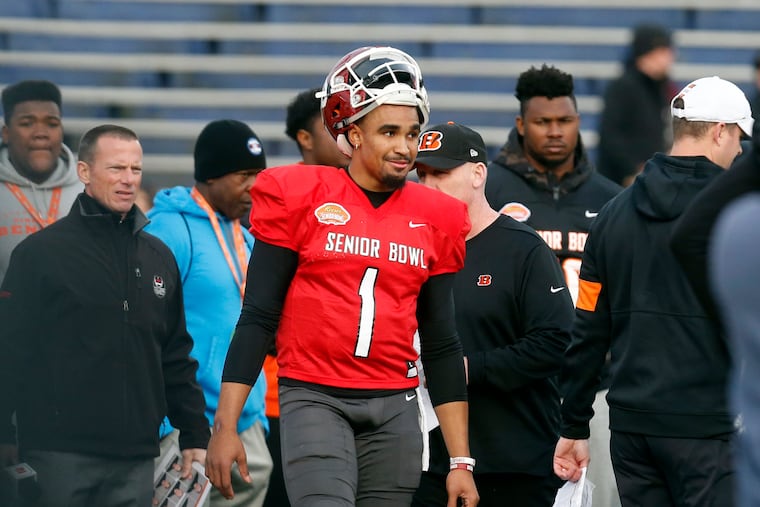What Senior Bowl speed-tracking tells us about Eagles draft pick Jalen Hurts’ arm strength, K’Von Wallace’s athleticism
Measuring an NFL prospect's ability goes far beyond his 40-yard dash. The Eagles' draft showed they had a particular kind of player in mind in the early rounds.

The day after the Eagles lost to the Seattle Seahawks in the first round of the playoffs, Howie Roseman jotted down the three core traits his team would seek during the offseason.
The first trait was speed. Above all else, the team that ranked 22nd in team speed by Next Gen Stats in 2019 had to get faster. The two fastest teams in the NFL last season, the 49ers and the Chiefs, both made it to the Super Bowl.
The Eagles GM went into the offseason looking for explosive, healthy, and passionate players both in the draft and free agency. The approach was easily spotted, made evident by the 40-yard dash times of nearly every draft selection they made last week.
The Eagles had the most athletic draft class by Next Gen Stats, which calculates a score with an equation that varies per position based on which combine drills have been strong indicators for success in the NFL.
The stopwatch in Indianapolis isn’t the only measurement tool available to teams, though. For the newest Eagles who participated in January’s Senior Bowl, there’s a week of radio frequency identification speed-tracking data available from Zebra Technologies to parse through.
Here’s how the Eagles’ class tested:
Jalen Hurts
The most surprising data on Hurts comes with the ball-tracking figures recorded. Among all quarterbacks at the Senior Bowl, Hurts had the best average initial air speed, which measures the speed of the ball coming out of his hands on the first two days of practice. He also had the highest average ball speed, average distance, and recorded the longest pass during the week.
Most scouting reports suggest Hurts’ arm strength is adequate, but few would suggest the Oklahoma quarterback’s arm talent is elite. Still, his 47.5 mph average was the fastest recorded at the Senior Bowl in the last two years when tracking was available. Oregon quarterback Justin Herbert, often praised for his arm strength, was clocked at 43.1 mph.
Hurts’ air speed most closely matches Josh Allen and Baker Mayfield, who were both recorded at 47.1 mph, and Eagles’ practice squad quarterback Kyle Lauletta, who was clocked at 47.4 mph.
Hurts was also the fastest running quarterback in Mobile, his top speed was 18.07 mph, which was comparable with running backs recorded during practice.
RFID tracking also records the average number of rotations the football is making out of the quarterbacks’ hands. Hurts ranked fourth among the six quarterbacks in that category.
What would this indicate?
“In general, what I’ve heard in discussion are coaches liking the rotational information as suggestive as the potential of their accuracy in different weather conditions,” said John Pollard, the vice president of business development at Zebra.
K’Von Wallace
Eagles fourth-round pick K’Von Wallace is the type of player who tests better with advanced numbers than he did in the scouting combine.
His 4.53 40-yard dash was ninth among safeties who ran at the combine, but he was still considered an elite athlete by Next Gen Stats. Thanks to an impressive 10-yard split, broad jump, and three-cone, Wallace got a 96 athleticism score, one of the best at the position, because the equation factors in more than just straight-line speed.
The Senior Bowl data backs up Next Gen Stats’ conclusion. He reached a maximum speed of 19.32 mph in Mobile, which placed him sixth among all safeties.
Pollard pointed out that maximum speed isn’t the most influential trait teams may look for when scouting box safeties. Wallace may not win a race against some of his classmates, but Pollard said the Senior Bowl data may indicate that his speed in a game context is better. While most players hit their top speed running unimpeded on special teams drills, Wallace’s top speeds came during coverage drills.
“He was the sixth-fastest player recorded during the one-on-one period across all defensive backs, corners, and safeties,” Pollard said.
Wallace’s combine testing and player tracking compare favorably to Chiefs safety Juan Thornhill, who started as a rookie last year, among others.
Davion Taylor
By taking Colorado linebacker Davion Taylor in the third round, the Eagles took a linebacker higher than they have since drafting Jordan Hicks in 2015.
Taylor’s projections are all over the place. He’s considered a raw athlete who needs development to become a starter. But just how athletic is he?
His 4.49 40-yard dash was third-fastest among linebackers behind just Isaiah Simmons and Willie Gay Jr. At the Senior Bowl, he was the fastest linebacker and the 12th fastest player overall, maxing out at 20.37 mph during the week.
Taylor’s max speed in Mobile would have put him in the upper percentile not just among draft prospects, but among starter-quality running backs in the NFL and even some receivers. For reference, Miles Sanders reached 20.9 mph last season, which was the fastest an Eagle had run in two years.
“He showed speed consistently throughout all of the drills,” Pollard said. “He was first in sprints on Wednesday among the linebackers and on that same day he was second in total distance traveled. ... That type of speed and capability is definitely attractive."
Time will tell if these athleticism scores equate to winning — this data is still new and without much of the sample size necessary to make solid comparisons to previous players. There is an early track record of these speed measurements mattering, though.